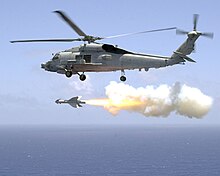AGM-119 Penguin
| AGM-119 Penguin | |
|---|---|
| General Information | |
| Type | Anti-ship missile |
| Manufacturer | Kongsberg Defense & Aerospace |
| Technical specifications | |
| length | 2950 mm (Mk I), 3180 mm (Mk III) |
| diameter | 280 mm |
| Combat weight | 330 kg (Mk I), 370 kg (Mk III) |
| span | 1420 mm (Mk I), 1000 mm (Mk III) |
| Drive First stage Second stage |
Solid rocket motor Solid fuel booster Solid rocket motor |
| speed | 700-800 km / h |
| Range | 20 km (Mk I), 40 km (Mk III) |
| Furnishing | |
| Target location | Infrared |
| Warhead | 113 kg (Mk I), 120 kg (Mk III) |
| Lists on the subject | |

Under the project name Penguin , the development of an anti-ship missile began in the mid-1960s on behalf of the Norwegian armed forces . Originally the rocket was developed to be fired from ships or from the coast, the later variants of the Mk. 2 or the Mk. 3 could also be used as an air-to-surface missile .
Versions
Mk 1
From 1972 the Penguin was used in the Norwegian Navy as a missile to be fired from coastal batteries . It was equipped with an infrared seeker head. The warhead is a further development of the Mk.19, which was also used in the AGM-12 Bullpup . It weighs about 113 kg, of which 43 kg is accounted for only by the explosives. The Mk. 1 could be fired blindly and then directed into a target marked with an infrared ray by a soldier. This resulted in a short warning time for the shot at . Their range was 20 km.
Mk 2
Compared to the Mk. 1, the range of the Mk. 2 has been increased to 30 km, and the seeker head has also been redesigned so that the Penguin is better suited for indirect fire. It was put into service in 1980 with the Norwegian Armed Forces and from 1987 in the US Navy as AGM-119 Penguin. The Mk. 2 has been modified more than seven times (Mk. 2 Mod 7 / AGM-119B) to date, one of which was the upgrade to an air-to-surface missile. The Mod 7, which entered service in 1986, is even more modern than the Mk. 3, as its development began later than that of the Mk. 3.
Mk 3
The Mk 3 is the air-to-ground variant of the Penguin, specially made for the Norwegian Air Force, which is only used by F-16 combat aircraft. It entered service in 1987. The main differences to the Mk. 2 were an elongated fuselage, shorter wings, a further increased range (40 km) and a digital flight control system. The Mk. 3 can be used as a sea skimmer . The Mk. 3 was designated AGM-119A by the US Forces, but was never put into service.
A total of around 1200 Penguin rockets are said to have been built. The Naval Strike Missile is seen as the successor to the Penguin , as the Penguin is now getting on in years despite various updates.
Countries of operation
![]() United States
United States
Between 1991 and 2001, Kongsberg delivered approx. 142 AGM-119B (Mk. 2 Mod 7) to the United States Navy in several tranches . There they are used on the SH-60 Sea Hawk.
![]() Greece
Greece
The Greek Navy was supplied with 120 Mk. 2 Mod 7s in three tranches . These are used on the SH-60B / F Sea Hawk and on guided missile speedboats of the La Combattante III class.
![]() Sweden
Sweden
The Penguin Mk. 2 Mod 7 is designated as Rb-12 in the Swedish Navy . 200 pieces were bought for the twelve Hugin class speedboats. The Hugin class had two launch containers on board and could transport a total of six missiles.
![]() Turkey
Turkey
The Turkish Navy ordered around 60 Penguin Mk. 1 for the Kartal class in 1971 and 32 Mk. 2 Mod 7 for the SH-60B Sea Hawk from 2001.
![]() Australia
Australia
As part of the SEA-1414 project, the Royal Australian Navy bought 84 Mk. 2 Mod 7 for their SH-2G Super Seasprite . It was also agreed that the warheads of the Penguin in Australia would be manufactured by ADI Ltd. PBXN-109 explosives are used for the warhead.
![]() Spain
Spain
The Spanish Navy got 2,004 20 Mk. 2 Mod 7 delivered for their SH-60B Sea Hawk. Spain has secured an option for more penguin.
![]() Brazil
Brazil
In 2008, Brazil ordered six SH-60B Sea Hawk and an unknown number of Penguin Mk. 2 Mod 7s for about 20 million US dollars for the Navy ( Marinha do Brasil ) .
